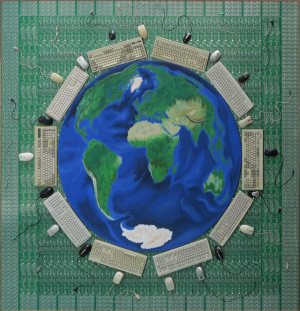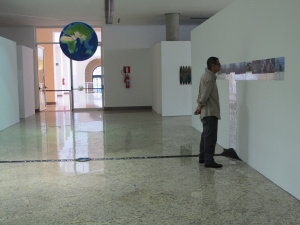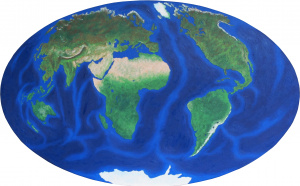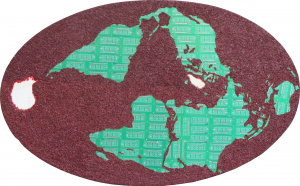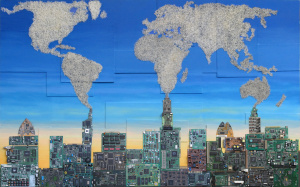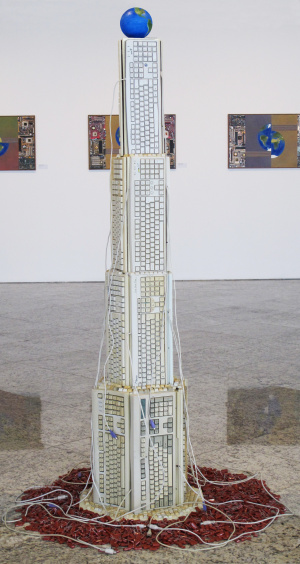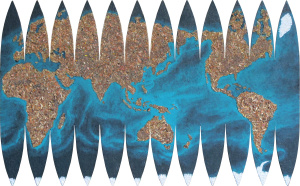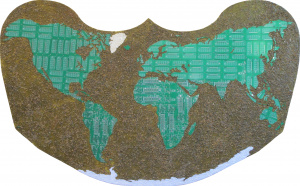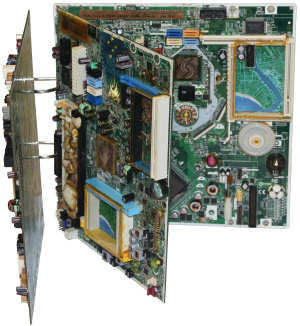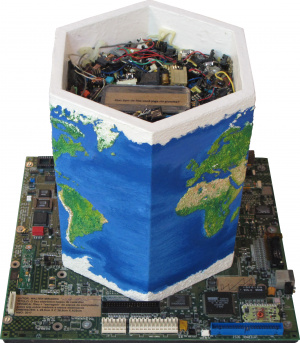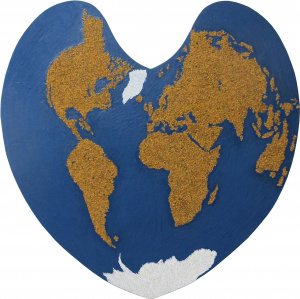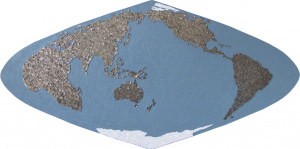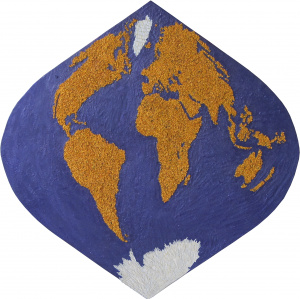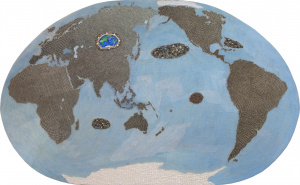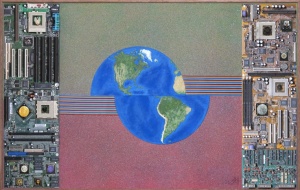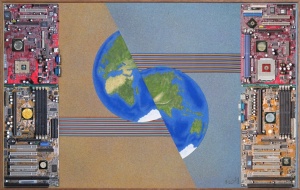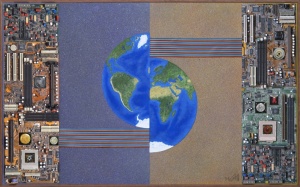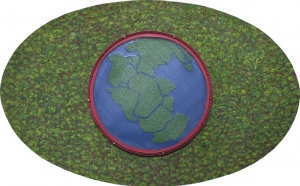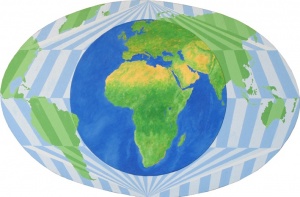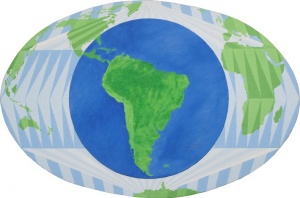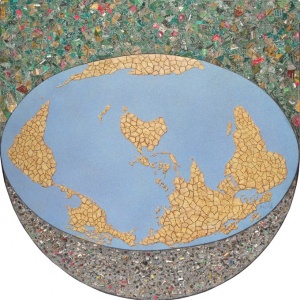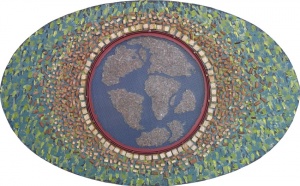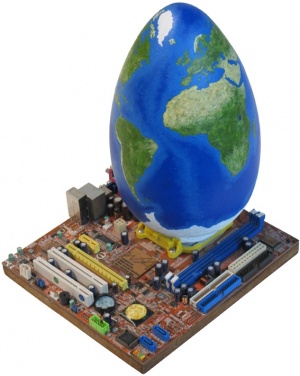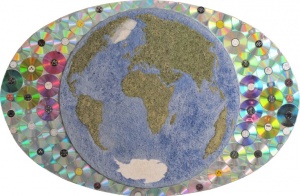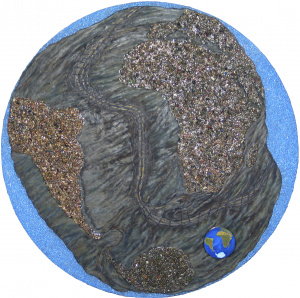Text of the Catalogue of the exhibition Cartographies of Gaia held at the Nilton Zanotti gallery at the Palácio das Artes in Praia Grande and at the Cultural Center of Correios in São Paulo.
CARTOGRAPHIES OF GAIA by Walter Miranda
Since the 1980s, the ecological theme has been a constant in my artistic production, as well as the incorporation of computer boards and other accessories of our technological daily life. The series of works called “CARTOGRAFIAS DE GAIA” presents works that reproduce several cartographic projections to deal with the current situation of environmental degradation on the planet. Planetary degradation, caused by the actions of human beings eager for immediate enrichment, immeasurable material comfort and the assumption that, with technology, we can dominate nature.
The two and three-dimensional works were carried out using the traditional technique of oil painting and the incorporation of objects discarded by contemporary society. The joint use of these two apparently antagonistic factors (tradition and contemporaneity) generates the compositional challenge of obtaining a visual harmonization during the creative process of each work that, when completed, provokes in the observer philosophical reflections on the pollution of the environment and the consequent decline of the quality of life for man on the planet.
The support for the works are wood, plastic objects, aluminum sphere and the traditional canvas. Objects discarded by contemporary society were incorporated into the supports, such as: computer boards (sawn and ground or in pieces and shards), electronic components (processors, chips, speakers, diodes, capacitors and resistors), computer keyboards, credit cards, revolver bullets, meat grinders, scales, keys, padlocks, clocks and clock domes, PVC (polyvinyl chloride) plastic film, acupuncture needles and straws, jewelry, coins, burnt matchsticks , sharpened pencil peels, eraser sharps, shards of glass, etc. I also incorporated elements from nature, such as: seeds, shells, snails, earth, sand, stones, armadillo shell, etc.
All the components I used were placed according to an aesthetic order in order to create unique textures and visual effects that provoke the viewer's curiosity. In some frames, I painted realistically (as a detail) the map of the region presented in the entire frame in order to create a link that closes the frame in itself, that is: the frame is a detail of itself and a detail of it is the whole frame.
Cartografias de Gaia has a total of 44 works in which I used the artistic interpretation of cartographic projections as follows:
TWO-DIMENSIONAL WORKS
• 1 panel measuring 2.5m X 2.5m was made with printed circuit boards, computer keyboards and pc mouses;
o This work presents the planet Earth as an egg being fertilized by human technology. It represents the extreme importance that man gives to the use of technology today. The planet was painted on canvas and is on a flat world filled with electronic boards. Thus, the Earth is represented as an egg, whose protective layer is composed of computer keyboards and the sperm that try to penetrate the egg are represented by pc mouses. Ironically, the only mouse sperm that can penetrate the egg shell is branded “Clone”.
• 5 works in oval, semicircular or multiform cartographic formats show all regions of the planet.
o These works were filled with credit cards (symbol of rampant consumerism); keys (symbol of opening or closing of human paths), computer boards (symbol of current technology), several CDs (which represent the brilliant and apparent richness provided by current technology), acupuncture straws and clips, electronic mini buttons, diodes, electronic resistors and capacitors etc.
o One of the boards was made with 30,000 electronic diodes + 2,500 straws and 1,600 acupuncture needle clamps + 500 capacitors and 400 electronic resistors. It also presents the five islands of plastic waste that float in a concentrated way in some parts of the oceans.
• 3 oval works with the world map represent the evolution of continents during geological ages.
o They represent the progression of technological pollution generated by humans over time, as the works establish an evolutionary parallel since the dawn of civilizations (when man spread across the planet using natural materials to conquer the environment) to the present day, in which man is polluting the planet in an unimaginable way. The tables were filled with guava seeds, sharpened pencil shavings and residues from electronic boards, plastics, metals, etc;
• 2 works show the shapes of the first world maps, created in 1507, where the representation of the Americas appears for the first time.
o One of them was filled with electronic circuit boards, guava seeds, and acupuncture needle loops; and another was filled with sharpened pencil shavings, which represent European deforestation in the 16th century.
• 6 circular works represent regions of the planet filled with the remains of objects that relate to the characteristics of each region, in order to represent the pollution caused by the excessive consumption of materials processed by the current industry.
o In South America, I used matchsticks to represent forest fires;
o In Europe, I used small pieces of computer boards to assemble a visual mosaic representing the various mini-regions that make up the continent;
o In Africa, I used sand due to the marked influence of the Sahara, as well as the drought in several regions of that continent;
o In North America, I used various computer chips and processors to represent the characteristic of the local technological society;
o In Asia, I used sharpened pencil peels to represent the manual culture that still remains imperative in the region today;
o In Oceania, I used computer board debris to represent the dominant industrial production in the region and which has been supplying the world market for electronic goods.
In the background of some works, I painted hands and feet (which represent the human occupation of the planet). In others, I handwritten a text, which follows linear compositional patterns specific to each work. This text is known worldwide as theLetter from Chief Seattle and has a very curious history:
American Indian chief Seattle gave a speech in 1855 during a peace treaty in which Indian lands were sold in exchange for a reservation. This speech was witnessed by an admirer of his, Henry A. Smith, who published it in a local newspaper in 1887, based on his recollections of the speech.
In 1971, the speech was altered by screenwriter Ted Perry for a documentary on ecology. From then on, the text became known worldwide as Chief Seattle's reply letter to US President Franklin Pearce.
Although authorship is ambivalent, this communion of texts, in my view, presents a message, which is becoming increasingly current, for humanity. Therefore, I decided to include it in part of this series of works. Those interested in the full text can access it on my website: http://www.fwmartes.com.br/imprensa/114/carta-do-chefe-seattle
• 2 circular works show the terrestrial poles;
o In Antarctica I used electronic components debris to represent the marks of human and scientific occupation in the continent still little explored;
o In the Arctic I also used sharpened pencil shells, however smeared with ink and oil, to represent the marks of human pollution on the sparsely inhabited continent.
• 1 circular work represents all continents viewed simultaneously and filled with pieces of computer boards completely smeared with industrial oil (another symbol of technological pollution).
• 1 circular frame, painted in dark colors, represents the image of the planet without water;
o In the painting “Sem Água (without water)”, I used a mixture of the tailings that I used in the other paintings to represent the continents and that, incorporated into the oil painting, become a dramatic representation of an image captured by means of radar and published by the European Space Agency showing what Earth would be like without water. This image is superimposed on a circle filled with shards of glass showing the limits of the water, which generates the rounded shape of the planet, instilled in our collective unconscious.
• 3 works of whimsical cartographies feature a world map filled with mini electronic push buttons, guava seeds and acupuncture needle loops;
o Two of them are lozenge-shaped, with the oceans being made in high relief using sawdust from printed circuit boards and electronics debris, and the Arctic and Antarctic areas being filled with loops of acupuncture needles. One has continents filled with 5,000 mini electronic push buttons and acupuncture needle clips.
o The third frame has a shape analogous to a heart, reproducing one of the various cartographic projections that exist.
• 2 works show the world map upside down.
o It is a tribute to the Uruguayan painter Joaquim Torres Garcia who, in the first half of the last century, postulated a new way of seeing the world without the conventional point of view used by Western culture.
• 1 oval work shows the world map painted in reverse, as if the viewer of the work was inside the frame watching the viewers of the work;
• 1 oval work, showing the map of the world “lying down”;
• 1 bilateral circular work (front and back) represents the real nature and beauty of the planet;
• 1 rectangular work made of wooden scraps, small computer boards and cut-out acupuncture straws, represent the visual beauty of atmospheric pollution;
• 3 rectangular works present the Earth cut out vertically, diagonally and horizontally, alluding to the environmental imbalance and the mismatch between the use of technology and integration with the planet in a sustainable way.
• 2 oval works present Africa and South America in evidence and the other continents in a faceted way;
o Africa and America are centered and realistically painted and the other continents are geometrically faceted. Thus, the central part is seen naturally and the sides as if they were the faces of a diamond to represent the planet seen through a prism and as a small jewel immersed in the infinity of the universe.
THREE-DIMENSIONAL WORKS
• 1 modular object mounted in the form of a tower, made with computer keyboards;
o The base of the object is octagonal, the first module is hexagonal, the second module is pentagonal, the third module is quadratic, the fourth module is triangular, and the top is composed of a sphere.
• 3 “Books of Gaia”, whose pages are computer boards + objects, tell the process of human technological development and its relationship with the planet, Gaia.
• 2 objects, “The Last Judgment Machine” and “The Vital Balance”, were made from the reuse of a meat grinder and a scale.
o The first features the Earth being ground in a meat grinder, and the second features the Earth on a scale as a man weighs the Sun and Moon. Both represent the objectification of nature and universal philosophical values, transforming them into mere material values.
• 2 three-dimensional objects that present the Earth in the shape of an egg coupled on computer boards address the ecological issues that can affect the climate balance on the planet.
• 1 hexagon-shaped object represents e-waste dumped around the planet.
INSTALATION REQUIEM TO GAIA - FOUCAULT’S ICU
• 1 installation composed of 1 circular and bilateral work with an image of the planet painted on the front and back; scanned images; 38,000 electronic push buttons; contact acetate for keyboards; electronic time markers; plastic globe; monitor top and abdominal subcutaneous syringe.
o The installation represents mother Gaia (planet Earth) in a serious health situation and in urgent need of the services of an ICU-Intensive Care Unit.
o Two opposing walls are used to represent the reality of the world we live in and the distance that human beings live from this reality.
o On the first wall are presented several images showing the pollution of the air, seas, forests and cities, as well as the garbage left by human beings in all corners of the planet. In the sequence, other images are presented showing dead or sick animals, for suffering the consequences of the environmental pollution generated by the human species.
o On the other wall are presented the same images framed by a television screen, aiming to convey the idea that the human being is aware of these situations, but acts as if everything were just a movie far from the reality of our daily lives. Around the screen are placed several credit cards that represent the world's financial power that direct what and how to present the news in the media of communication.
o Connecting the two walls and supporting the monitor, there is a “road” of computer keyboard acetates that represents the technological evolution of the human being. It is filled with thousands of electronic push buttons that surround an image of planet Earth surrounded by electronic time markers.
o Between the two walls, in the center of the road, there is a Foucault pendulum that supports a circular double-sided painting hanging two and a half meters high. This painting has on the front and back the continents painted in a realistic way and represents the perception that the human being has that: when everything is mapped, everything is mastered!
o A little below the painting, and hanging from the pendulum, there is a small terrestrial globe that represents the finitude of the planet. Further down, there is a subcutaneous syringe pointing menacingly at the image of planet Earth surrounded by electronic time markers.
o In consonance with the paintings on display, the essential idea of the installation is to demonstrate the finitude of planet Earth and remember that the weight of our actions puts the planet itself and our lives at risk.
PERFORMANCE
• 1 performance in which the serious ecological situation in which the planet finds itself due to human actions is addressed. The play lasts twenty minutes and counts with the participation of the group “Suspiro na Arte”. It presents the fictitious sale of planet Earth by a super-powerful businessman who does not care about the social and economic injustices existing between countries.
o In consonance with the paintings on exhibition, the essential idea of the installation and the performance is to demonstrate the finitude of planet Earth and remember that the weight of our actions puts the planet and our lives at risk.
Finally, it should be said that this series of works, in which I use the world map to express my current concerns, emphasizes my “modus operandi”, since in all my artistic production, I always try to unite reason with emotion (base of my creative process) in order to create a work that makes use of traditional techniques incorporated into elements of today's society to establish different metonymic relationships that provoke questions in the viewer.
In this sense, the subjective language I use to express my feelings, anxieties, ideas and philosophical concepts allows the observers to draw their own conclusions about the topic addressed in each series of work. The result is complicity or denial, it doesn't matter. Both form a kind of involvement that refers to the essence of what I try to convey.
Walter Miranda - August/2019
